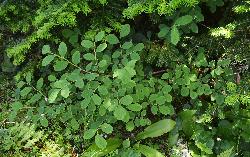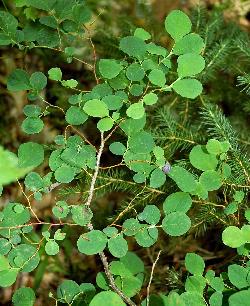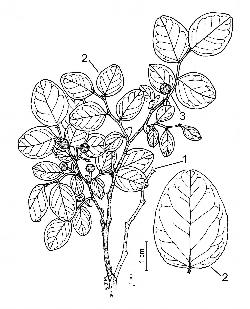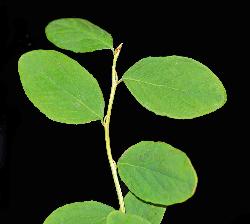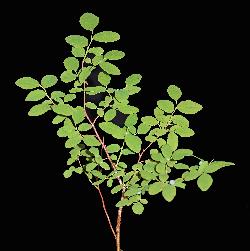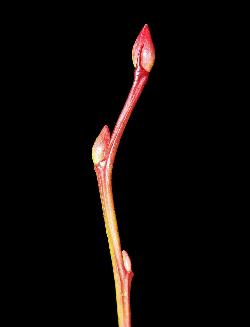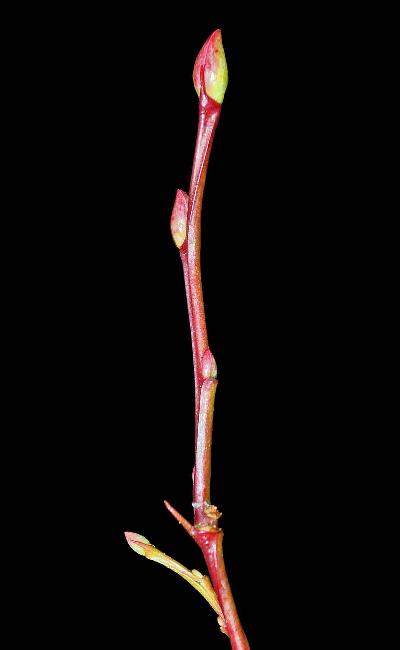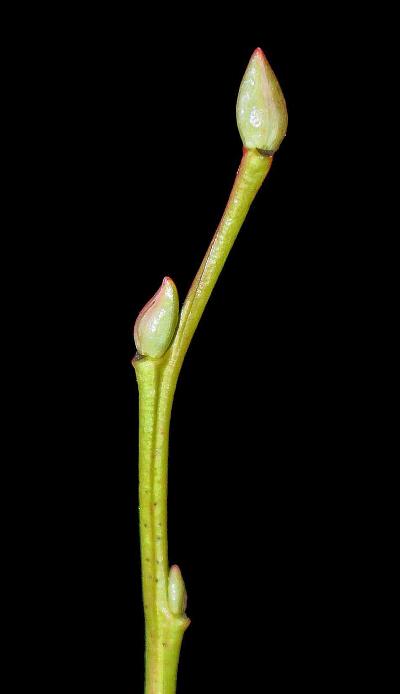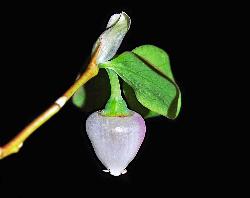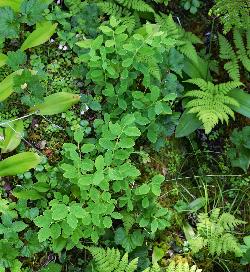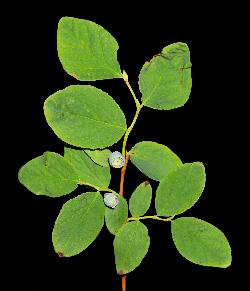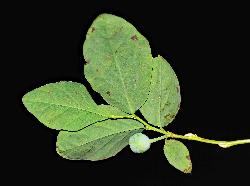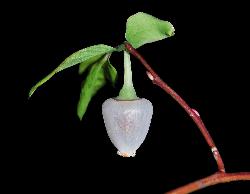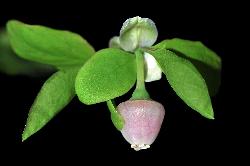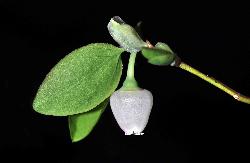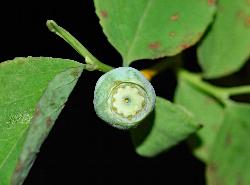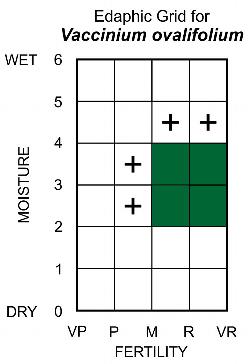Fr: airelle à feuilles ovées, airelle bleue, airelle à feuilles ovales
Ericaceae - Heath Family
Note: Numbers provided in square brackets in the text refer to the image presented above; image numbers are displayed to the lower left of each image.
General: A low deciduous shrub, 3–15 dm tall, with open spreading branches [1–4]; rhizomes are lacking. Ovalleaf bilberry is typically found in moist shaded forest habitats, often near rock outcrops or in rocky soils. Bilberries (Vaccinium Sect. Myrtillus) have several traits that separate them from true blueberries (Vaccinium Sect. Cyanococcus), the most noticeable difference is that bilberries bear solitary flowers in the axils of their leaves, while blueberries bear terminal racemes of several flowers from lateral and/or pseudoterminal buds in the upper portions of the stem.
In western Canada, Vaccinium ovalifolium is commonly called ovalleaf huckleberry (Vander Kloet 2009) or tall huckleberry (Scoggan 1979), but the common name huckleberry is usually applied to ericaceous plants in the genus Gaylussacia, which does not occur in western Canada. The current nomenclature includes the Alaskan bilberry (Vaccinium alaskaense Howell) in synonymy with V. ovalifolium, but this change has not been universally accepted. V. alaskaense is often accepted in western North America as a distinct species; it is tetraploid, can grow to 4 m tall, has flowers that bloom as or after the leaves emerge, longer pedicels (10–20 mm), more globose corollas, and blackish fruit (Vander Kloet and Dickinson 1999). Due to the large number of variable traits, the following description treats Vaccinium ovalifolium as distinct from V. alaskaense.
Key Features: (numbers 1–3 refer to the illustration [5])
1. Stems are usually reddish brown (at least on the upper side), smooth, glossy, and have a small spine-like extension at the end of each twig.
2. Leaves are alternate, elliptic, oval, to broadly ovate, 1.5–5 cm long, and margins are mainly entire, except for a few blunt teeth near the base of the blade.
3. Berries are solitary in leaf axils and bear a circular scar at the top, rather than the persistent crown of 5 triangular calyx lobes characteristic of true blueberries.
Stems/twigs: Young branches are green, glabrous to glaucous, smooth to glossy, and longitudinally angled [6]. Winter twigs and young branches are deep reddish-brown, or sometimes reddish-brown on the upper surface [7–8] and green or yellowish beneath [9]; older stems are a dull light to dark brown. True terminal buds are absent; the pseudoterminal bud is subtended by a slender extension of the undeveloped stem tip [7]. This spine-like extension is also visible at the base of each year's growth [8] and subtending newly emerging leaves and flowers [10]. The ovoid buds have 2 smooth outer valvate bud scales that are connate along their margins; pseudoterminal buds are larger than the lower lateral buds, which are lanceoloid; leaf scars are small and hemispherical with a single bundle trace scar. Older stems are purplish gray to dark brown with flakey bark.
Leaves: Alternate, simple, and pinnately-veined. The short petioles are 1–2 mm long and bend slightly so that leaves of each branch are displayed in a single flat plane [11–12]. Young leaves are often elliptic with serrate margins, while fully expanded leaf blades are broadly oval, ovate, or nearly orbicular with entire margins, except for a few blunt teeth near the leaf base [13]. Mature leaf blades are 1.5–5 cm long by 0.5–2 cm wide, green to bluish-green and dull above, glabrous on both surfaces, and paler to sometimes glaucous beneath [14]. Bases are tapering to rounded, and apices are blunt (obtuse) to rounded or slightly indented (retuse). Ovalleaf bilberry leaves have a thinner, more membranaceous, texture than the stiffer somewhat coriaceous leaves of local blueberries. The leaves turn a dull purplish brown in autumn.
Flowers: Single flowers are borne in the axils of the first emerging leaves of the current year's growth [15–16], and bloom in early spring before or as the first leaves emerge. Flowers are borne at the end of short pendant pedicels, 3-6 mm long, which are continuous with the short calyx tube [17–18]. The calyx has 5 very short, broad, nearly obsolete lobes that subtend the flat base of the corolla. The corolla is pinkish-white to white, small, 5–7 mm long, and urn-shaped (urceolate) to conical [19]; the mouth of the corolla is very narrow and ends in 5 small reflexed lobes [20]. The 10 stamens have glabrous filaments and anthers with elongate tubes ending in terminal pores through which pollen is shed. The single pistil has an inferior ovary and one style, surrounded at the base by a broad nectar disk. As in other Vaccinium species, pollination of ovalleaf bilberry is primarily by bees (melittophily), and cross-pollination is necessary for good fruit set (Javorek et al. 2002, Usui et al. 2005). To collect pollen from blueberry flowers, visiting bees must vibrate the flowers in a specific way, a process called buzz pollination or sonication. This method of gathering pollen is characteristic of larger solitary bees, e.g., bumblebees (Bombus spp.) and andrenid mining bees (Andrena spp.) (Buchmann 1983). Honeybees and other smaller bees and pollinators do not sonicate, so cannot effectively pollinate Vaccinium flowers.
Fruit: A globose dark blue-black berry, borne singly in leaf axils and usually with a pale glaucous bloom that is easily removed when rubbed [20–21]. Berries are 6–10 mm in diameter and have a circular scar at the top, marking where the very reduced calyx lobes had been attached [22–23]. Although not as sweet or palatable as those of other blueberry species, ovalleaf bilberry fruits are edible. Fruits mature in mid to late summer. Fruits mature in late summer to fall and are dispersed primarily by mammals and birds (endozoochory).
Ecology and Habitat: Ovalleaf bilberry is found infrequently and in low abundance in the province, usually in forests of western and northern Newfoundland that occur on mineral soils, and occasionally forested fens influenced by limestone. It forms small patches that are easily missed among the lush fern and herb growth on these sites. Ovalleaf bilberry is an indicator species that differentiates the Abietum dryopteretosum-Rhytidiadelphus variant (Dryopteris-Rhytidiadelphus-Balsam Fir Forest variant Subassociation) from other fern-dominated forests.
Edaphic Grid: See image [24]: the Edaphic Grid for Vaccinium ovalifolium.
Forest Types: Ovalleaf bilberry is never abundant, but frequently found in the following forest types:
Abietum clintonietosum (Clintonia-Balsam Fir Forest Subassociation)
Abietum dryopteretosum-Rhytidiadelphus variant (Dryopteris-Rhytidiadelphus-Balsam Fir variant Subassociation)
Abietum rubetosum (Rubus-Balsam Fir Forest Subassociation)
Abietum sphagnetosum (Sphagnum-Balsam Fir Forest Subassociation)
Abietum taxetosum (Taxus-Balsam Fir Forest Subassociation)
Osmundo-Piceetum (Osmunda-Black Spruce Fen Association)
Succession: Ovalleaf bilberry is a widely distributed species in North America, but the sporadic disjunct populations in Newfoundland appear to be smaller in stature and different in habitat. The Newfoundland plants rarely exceed 25 cm and do not form large patches. They also seem to have a distinct preference for limestone soils. Most of the descriptions from other parts of its range suggest a preference for acidic soils, which is generally true for the genus. It is generally shade-tolerant but can occur in the partial shade of open forested fen habitats. Like most plants of this genus, it can regenerate through seed, but appears to spread more readily through root sprouts and layering. Reports from other regions suggest that this species can survive fire and cutting (Tirmentein 1990) but little is known of its disturbance ecology in Newfoundland; there is no data on its habitat or ecology in Labrador.
Distribution: Ovalleaf bilberry has a broad disjunct range, with its main contiguous range in the mountains of western North America (the Pacific Cordillera) and eastern Asia. The eastern disjunct area extends from Newfoundland and Labrador west to Québec; there is also a small disjunct area in the eastern Lake Superior region of Ontario (Algoma District) and northern Michigan. In the west, its main range extends from the southern Yukon through British Columbia south to Oregon (Vander Kloet 1988). Within insular Newfoundland, ovalleaf bilberry occurs in western Newfoundland and the Great Northern Peninsula, with an outlier in the eastern Baie Verte Peninsula (Rouleau and Lamoureux 1992). In Labrador, it occurs north to Chateau (about 52° N), in southeastern Labrador (Scoggan 1979).
Similar Species: Bilberries can be distinguished from true blueberries by the number and arrangement of their flowers. Bilberries bear solitary flowers in the axils of their leaves, while blueberries bear terminal and axillary racemes of several flowers. Bilberry flowers also have stamens with 2 downward-pointing awns on the back of the anthers, while blueberry flowers have awnless anthers, although both bilberries and blueberries shed their pollen through elongate terminal pores. The only other bilberry species in the province is the dwarf bilberry (Vaccinium caespitosum Michx.), which occurs throughout much of Labrador; it can be recognized by its small size (usually below 2 dm tall) and its oblanceolate to obovate leaves, 1–2.6 cm long, which have serrate margins.


